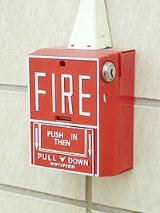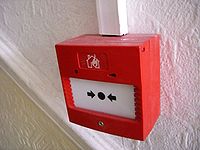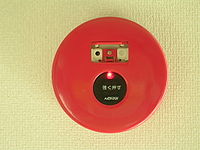
Fire alarm pull station
Encyclopedia


Fire alarm pull station
A fire alarm pull station is an active fire protectionActive fire protection
Active fire protection is an integral part of fire protection. AFP is characterised by items and/or systems, which require a certain amount of motion and response in order to work, contrary to passive fire protection.-Fire suppression:...
device, usually wall-mounted, that, when activated, initiates an alarm on a fire alarm system. In its simplest form, the user activates the alarm by pulling the handle down, which completes a circuit and locks the handle in the activated position, sending an alarm to the fire alarm control panel
Fire alarm control panel
A Fire Alarm Control Panel , or Fire Alarm Control Unit , is the controlling component of a Fire Alarm System. The panel receives information from environmental sensors designed to detect changes associated with fire, monitors their operational integrity and provides for automatic control of...
. After operation, some fire alarm pull stations must be restored to the ready position using a special tool or key in order to deactivate the alarm sequence and return the system to normal. Primitive manual stations requiring only a single action or hand motion to activate, can be subject to unwanted activation by jarring or accidental contact. Early strategies to cope with this problem included requiring the operator to break a pane of glass to release an internal spring operated mechanism. Manual pull stations that require two hand motions such as; lift up and pull down or push in and pull down have since replaced the break glass and single action models in many modern installations.
Coded pull stations
In the past, pull stations controlled the entire system. These coded pull stations were much bigger than modern pulls and had a code wheel in them. This was a gear mechanism that was wound up when the station was pulled (and, unlike modern pull stations, the handle did not stay down). The gears would turn a small wheel with a specific number of teeth, which determined the coding. The teeth would push up on a contact, which would open and close a circuit, pulsing the code to the bells or horns. This code was used by building security to determine where the alarm was originating from. Example: a pull station in the fourth floor elevator lobby of an office building has a code of 5-3-1. When the station is pulled, the security officers in the building look up 5-3-1 in a master list of codes. After finding the location of the pull, they check to see if there is a real fire. If there is, they evacuate the building and call the fire department.
Fire alarm notification appliance
A fire alarm notification appliance is an active fire protection component. A notification appliance may use audible, visible, or other stimuli to alert the occupants of a fire or other emergency condition requiring action. Audible appliances have been in use longer than any other method of...
to sound continuously (or in the case of single-stroke bells, ding once). Turning it the other way and then activating the pull allows a silent test to be done in which the station's mechanical parts are checked to ensure proper function. Once pulled, the station would do at least four rounds of code before resetting itself. Coded pulls were typically used in new fire alarm systems until roughly the 1950s, and then occasionally up until the 1970s. Up until the late 1980s and early 1990s, some panels were made with an extra zone to accommodate any existing coded pull stations. Nowadays, coded pull stations are very rare and almost never seen in working fire alarm systems.
Modern pull stations
Many modern fire alarm pull stations are single action and only require the user to pull down the handle. Other fire alarm pull stations are dual-action, and as such require the user to perform a second task before pulling down, such as lifting up or pushing in a panel on the station or shattering a glass panel with an attached hammer. Perhaps the most recognizable pull station is the T-bar style pull. The style is so named because the handle is shaped like the letter "T". This style is manufactured by many companies.Resetting a fire alarm pull station after it has been operated normally requires building personnel or emergency responders to open the station using a key, which often is either a hex key
Hex key
A hex key, Allen key, or Allen wrench is a tool of hexagonal cross-section used to drive bolts and screws that have a hexagonal socket in the head .- Nomenclature :...
or a more traditional key. Opening the station normally causes the handle to go back to its original position, allowing the alarm to be reset from the fire alarm control panel
Fire alarm control panel
A Fire Alarm Control Panel , or Fire Alarm Control Unit , is the controlling component of a Fire Alarm System. The panel receives information from environmental sensors designed to detect changes associated with fire, monitors their operational integrity and provides for automatic control of...
after the station has been closed.
In areas where false calls are a problem, pull stations may be covered with a clear plastic cover that sounds a loud tamper alarm when removed, creating focus on the fire alarm. If this is not a sufficient deterrent, the pull handle may be treated with ink, powder, or gel dye which can be used to help identify who pulled the alarm.
Manual call points
In Europe, Australia, New Zealand, and Asia, pull stations are generally not used; instead a manual call point is used, which is usually referred to as an MCP within the fire protectionFire protection
Fire protection is the study and practice of mitigating the unwanted effects of fires. It involves the study of the behaviour, compartmentalisation, suppression and investigation of fire and its related emergencies, as well as the research and development, production, testing and application of...
industry, as a "transmitter" in Japan, or as a "break glass" by the UK public. They are used to allow building occupants to signal that a fire or other emergency exists within the building. They are usually connected to a central fire alarm panel
Fire alarm control panel
A Fire Alarm Control Panel , or Fire Alarm Control Unit , is the controlling component of a Fire Alarm System. The panel receives information from environmental sensors designed to detect changes associated with fire, monitors their operational integrity and provides for automatic control of...
which is in turn connected to an alarm
Alarm
An alarm device or system of alarm devices gives an audible or visual alarm signal about a problem or condition.Alarm devices include:* burglar alarms, designed to warn of burglaries; this is often a silent alarm: the police or guards are warned without indication to the burglar, which increases...
system in the building, and often to a local fire brigade dispatcher
Dispatcher
Dispatchers are communications personnel responsible for receiving and transmitting pure and reliable messages, tracking vehicles and equipment, and recording other important information...
as well. The first modern MCP arrived in Europe in 1972 and was developed by KAC.
MCPs would historically be printed with FIRE as a title above a glass element, where the element would be glass which would be covered with plastic. This element design would be the old British Standard. The new European Standard, EN 54
EN 54
European standard EN 54 specifies requirements for all component parts of a fire alarm system. In the United Kingdom it superceeded BS 5445:Part 1:1977. BS EN 54-1:1996 was published in December 1996.The standard has been published in a number of parts:...
, says that the title should be the House Flame symbol, and the glass would appear differently. The glass will still be covered with plastic on the printed side.
Previously, the old British standard did not allow hinged covers and plastic resettable elements. Plastic elements must have the same printing as the EN54 glass.

